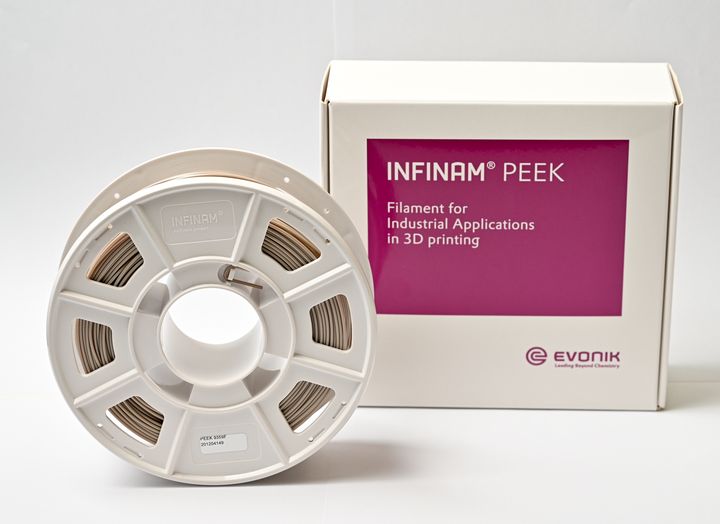
Evonik announced a new material, and I had a thought while reading through their announcement.
Evonik is one of the several major chemical companies addressing the increasingly diverse needs of the 3D printing universe. Those demands are increasing primarily due to vastly increased professional and now industrial use of the technology, which requires ever-more-powerful materials.
The company has now announced a new PEEK filament. They said:
“Evonik has developed a new 3D printable filament based on PEEK (polyether ether ketone). The high-temperature and chemical-resistant ready-to-use material is particularly suitable for the additive manufacturing of demanding industrial plastic parts. The high-performance polymer can be processed in common extrusion-based 3D printing technologies such as fused filament fabrication (FFF) or fused deposition modeling (FDM). Evonik is launching the new filament under the brand name INFINAM PEEK 9359 F.”
So far, this is pretty normal. PEEK is not a new material, and the sources from which you can obtain some are increasing, particularly with Evonik’s announcement.
PEEK has been a highly desirable material for 3D printing because of its unique properties:
- Chemical resistance
- High strength
- High temperature resistance
It’s one of the few 3D print materials that can be used in demanding mechanical applications or unusual environments.
It has not been extensively used in 3D printing until recently due to the lack of equipment able to handle the very high temperatures required for processing. However, that’s changed as multiple vendors now offer high-temperature gear that paves the way for increased use of PEEK and other high-temperature materials.
But then the Evonik announcement slides in another direction:
“Compared to stainless steel, 3D parts made of INFINAM PEEK 9359 F are approximately 80 percent lighter and 30 percent tougher with excellent fatigue resistance. This combination of properties makes Evonik’s new filament the preferred high-performance material as a metal replacement in demanding lightweight applications. INFINAM PEEK 9359 F also boasts outstanding wear resistance and low sliding friction, making it ideal for manufacturing lightweight structural parts.
The 3D components printed from INFINAM PEEK 9359 F can withstand long-lasting temperature effects of 250C or short-lasting temperature effects of over 300C.”
They’re comparing a thermoplastic with metal!
At first glance this might seem slightly crazy: how could a plastic material be used instead of metal? Metal is incredible strong and durable, and any thermoplastic, even PEEK, cannot compete.
On the other hand, maybe it can.
In the past metals were commonly used in any even-slightly-demanding application, simply because metals are easily obtained and processed. It became a rule of thumb: if the application requires any notable amount of mechanical or thermal stress, just use metal.
But with today’s much more accessible 3D print capabilities, the decision-making process needs to change.
The “line” of demarcation between plastic and metal applications has become a bit fuzzier. The decision is not so clear and requires a more detailed analysis.
Since PEEK’s thermal resistance is so high, you have to examine the application to see if the temperature actually exceeds those values. If not, then PEEK could be used as effectively as metal materials.
There’s another benefit: weight. Metals, while strong, are also heavy. PEEK is dramatically lighter, and this can make a significant difference in the application, particularly in these days of drone, vehicle and aerospace competition: the lightest solution usually wins.
You might not make an internal combustion engine entirely from PEEK, but you could make many parts for one with PEEK.
I believe this type of decision will become increasingly common, as materials such as PEEK gradually absorb some of the lower-temperature parts usage that were traditionally made with metal.
Via Evonik
